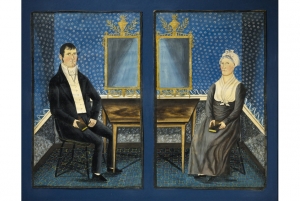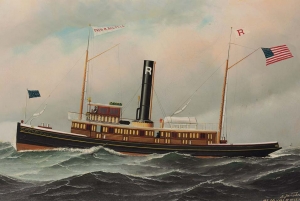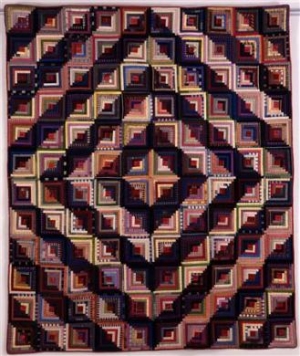|
Displaying items by tag: American Folk Art
New England was at the forefront of the industrial revolution. It was also a prime location for the rise of the middle class and evolution of the American folk art movement.
These elements of 19th century American life are documented in a new exhibition Folk Art, Lovingly Collected, on view at the Worcester Art Museum July 15-Nov. 29.
It features more than 40 works from an important private collection, based in central Massachusetts that is recognized as one of the best of its kind in existence.
On Friday, January 23, 2015, Allan Katz, a collector and dealer of period American folk art and Americana, debuted a new catalogue at the opening of the prestigious Winter Antiques Show in New York City. Brimming with beautifully photographed folk art objects and Americana, the catalogue offers a glimpse into Katz’s illustrious inventory.
Highlights from the catalogue include “Dude” -- a carved and paint-decorated wood and metal figure with fabric clothing. Created around 1910, “Dude” was part of Andy Warhol’s extensive American folk art collection. The Pop artist began collecting in the 1950s and in 1977, New York City's American Folk Art Museum featured his collection in the exhibition Folk and Funk.
A 1930s shoeshine stand bedecked with gilded knobs and beaded fringe, which was once exhibited at the Museum of Modern Art — where it played a role in a famous director’s ouster — resurfaced last month and is headed back into the public eye.
The Fenimore Art Museum in Cooperstown, N.Y., purchased the imaginatively decorated stand, which was created by an Italian immigrant bootblack, Giovanni Indelicato, who ran a makeshift booth on lower Broadway and sometimes went by the name Joe Milone. The Fenimore bought it a few weeks ago for $10,000, after the New York folklorist Joseph Sciorra of Queens College, a specialist in Italian-American culture, alerted the museum, which has a specialty in American folk art, that the piece had re-emerged after decades in obscurity.
New York’s American Folk Art Museum has launched a public, digital archive of 117 issues of magazines published by the institution between 1971 and 2008. ‘The Clarion,’ which was later renamed ‘Folk Art’ was published three times a year and served as a leading forum for original research and new scholarship in the realm of American folk art. The archive, which is organized chronologically, includes original articles, photographs, illustrations, advertisements and calendars.
The digitization and archive creation was made possible thanks to a grant from Museum Trustee Karin Fielding and her husband, Dr. Jonathan Fielding as well as donations from the Friends of Heritage Preservation and the American Folk Art Society.
The archive can be found on the American Folk Art Museum’s website.

On January 25, 2014 Sotheby’s will hold the auction Visual Grace: Important American Folk Art from the Collection of Ralph O. Esmerian in New York. The sale includes over 200 works including watercolors, portraits, pottery, painted furniture, weathervanes, carvings, needlework, sculpture and scrimshaw. Together, the collection marks the most important assemblage of American folk art to ever appear at auction. The sale carries a pre-sale estimate of $6.4 million to $9.5 million.
Nancy Druckman, Head of Sotheby’s Folk Art Department, said, “Ralph Esmerian is known for his profound connoisseurship, discernment and passion for the best in American folk art. Each of the examples in the collection is distinguished by the highest quality in design, pattern, color, texture and form. A pervasive respect and understanding of the inspiration and expertise of the various makers is present in each of the pieces, as they represent both the traditions and inventiveness of American art.”
Highlights from the sale include a drawing of a man with a plough by outsider artist Bill Traylor, an important Federal paint decorated slant front desk attributed to Johannes Braun and a rare fireboard with a view of Boston Harbor from 1825-35.
The Ralph Esmerian collection will be on view in Sotheby’s York Avenue galleries during Americana Week in New York beginning January 18, 2014.
Historic Deerfield’s President Philip Zea will lead a trip September 6-9, 2013 to view premier collections of antiques and decorative arts in Chicago and Milwaukee.
The trip includes special tours of five outstanding private collections and three remarkable area museums. Private collections include two top American decorative arts collections, an American folk art collection, Crab Tree Farm, and the MacLean Map and Book Collection. Special museum tours include the Art Institute of Chicago, Driehaus Museum, the Milwaukee Art Museum and a presentation and private viewing at the Chipstone Foundation’s Fox Point Georgian mansion of the foundation’s founders Stanley and Polly Stone. You can register by calling 413-775-7176. A few slots are available. See www.historic-deerfield.org/trip for details.

On September 24th, Christie’s presented their American Furniture, Folk Art, and Decorative Arts Sale in New York. Spanning the 18th and 19th centuries, works included furniture from the Wunsch Americana Foundation, the Philadelphia Museum of Art, and American folk art and maritime paintings. The sale was 85% sold by lot and 93% by value.
The top lot was a Chippendale carved mahogany easy chair that was entrusted to Christie’s by the Philadelphia Museum of Art. Estimated at $600,000-$900,000 and attributed to the renowned yet mysterious Garvan carver, the chair brought in $1.16 million, the third highest price ever paid for the form. “We are thrilled to have been the successful bidders on the Garvan Carver easy chair. It is a wonderful chair,” said Todd Prickett of C.L. Prickett who specializes in American antiques. The Museum will use the funds for new acquisitions.
Another lot that brought in more than expected was a Queen Anne Japanned Maple Bureau Table. One of about forty known examples of japanned furniture from colonial America, it is the only bureau table known to exist. Estimated at $60,000-$90,000, the table sold for $98,500.
Two paintings by the maritime artist, Antonio Nicolo Gasparo Jacobsen (1850–1921), sold for more than their estimates that ranged from $12,000 to $18,000. The Paddlewheel Steamer St. John went for $45,000 while Fred B Dalzell went for $25,000.
Not all lots did as well as anticipated. A pair of Federal eagle-inlaid mahogany side chairs attributed to William Singleton were estimated at $60,000 to $90,000 but only sold for $32,500. The pair of chairs had been lent to the Diplomatic Reception Rooms at the Department of State in 1968 and remained in the Monroe Reception Room as part of a larger set of four related chairs until they were returned to the Wunsch Americana Foundation. Until know, the location of this particular pair was unknown.

"Unfolding Stories: Culture and Tradition in American Quilts," an exhibition at the Fenimore Art Museum in Cooperstown, New York, features some of the best works of the rich tradition of quilting .
Jacqueline Atkins, the curator of the exhibition that runs from September 24 until December 1, and the author of several books on the subject, describes quilt making as "the true, great American folk art."
Many of the patterned quilts seem to anticipate Pop Art's fascination with geometric shapes, lines and repetition -- in some cases over half a century earlier.
Log Cabin, variation; Barn Raising, 1880-1890, by Anna Lay Park is an array of multicolored concentric cubes in a combination of different fabrics.
"They are really mind-boggling -- eye dazzlers comes to mind," Atkins said in an interview. "Looking at them if you didn't know when they were made you could say this is Pop Art."
But rather than compare the works to later developments of which the artists could have had no knowledge, Atkins likes to say that these women created their own distinct style and visual language.
"It was the women that started a whole art revolution on their own in fabric that only was found within the broader mainstream culture much later on," she explained.
The tradition, which reached its apogee in the 19th and 20th centuries, still has many millions of practitioners around the world.
Atkins said the quilts are highly collectible and the best examples have sold for close to $100,000 at auction.
|
|
|
|
|